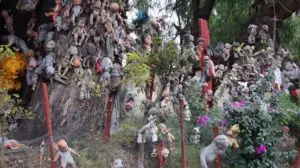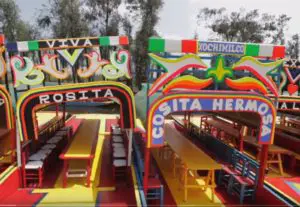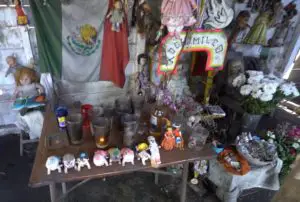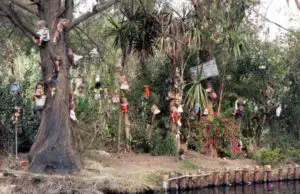Podcast: Play in new window | Download
Subscribe: Apple Podcasts | RSS
 Beyond the hustle and bustle of the gigantic magnet and monster called Mexico City, but still within the capital’s Federal District, an eerie and otherworldly place exists in the canals built by the ancient Mexicans over a millennium ago. In the municipality of Xochimilco, in the southern part of the Distrito Federal, fragments of the ancient lake system of the Basin of Mexico still survive, along with the unique style of farming on artificial islands called chinampas. For years, chinampas were referred to as “floating gardens” and the “Floating Gardens of Xochimilco” were known the world over. The term “floating garden” is somewhat fanciful and romantic and doesn’t really describe what a chinampa actually is. Chinampas don’t float, rather, they are raised square or rectangular plots of land used for farming in shallow lakes. A chinampa field is essentially a series of artificial islands connected by a series of canals. For more in-depth information about chinampas, please see Mexico Unexplained episode number 191: https://mexicounexplained.com/chinampas-floating-gardens-of-ancient-mexico/ In the year 2021 the chinampas are not what they used to be, and while this unique way of farming surrenders itself more and more to urban sprawl every year, tourism to the canals of Xochimilco keeps dwindling from what seemed to be its peak in the 1940s and 1950s. A curious and somewhat unlikely tourist attraction has saved this area from complete indifference shown to it by the outside world, however, and that is the creepy and haunting Island of the Dolls, known as La Isla de las Muñecas in Spanish.
Beyond the hustle and bustle of the gigantic magnet and monster called Mexico City, but still within the capital’s Federal District, an eerie and otherworldly place exists in the canals built by the ancient Mexicans over a millennium ago. In the municipality of Xochimilco, in the southern part of the Distrito Federal, fragments of the ancient lake system of the Basin of Mexico still survive, along with the unique style of farming on artificial islands called chinampas. For years, chinampas were referred to as “floating gardens” and the “Floating Gardens of Xochimilco” were known the world over. The term “floating garden” is somewhat fanciful and romantic and doesn’t really describe what a chinampa actually is. Chinampas don’t float, rather, they are raised square or rectangular plots of land used for farming in shallow lakes. A chinampa field is essentially a series of artificial islands connected by a series of canals. For more in-depth information about chinampas, please see Mexico Unexplained episode number 191: https://mexicounexplained.com/chinampas-floating-gardens-of-ancient-mexico/ In the year 2021 the chinampas are not what they used to be, and while this unique way of farming surrenders itself more and more to urban sprawl every year, tourism to the canals of Xochimilco keeps dwindling from what seemed to be its peak in the 1940s and 1950s. A curious and somewhat unlikely tourist attraction has saved this area from complete indifference shown to it by the outside world, however, and that is the creepy and haunting Island of the Dolls, known as La Isla de las Muñecas in Spanish.
 About 15 miles south of the central core of Mexico City, the visitor is transported to another world when entering the Xochimilco Ecological Reserve. At the Embarcadero de Cuemanco 100 or so colorful boats called trajineras line the docks waiting for tourists. For around 350 pesos per hour one can charter one of these colorful boats to explore the canals. It is quite remarkable to be in the heart of nature in these primeval waterways – surrounded by tall trees, blooming flowers, and teeming wildlife – and be so close to one of the world’s largest metropolitan areas. The trip to the Island of the Dolls takes about an hour and a half in one of these gondola-like canal boats and along the way there are 2 or 3 “fake” doll islands set up by some families working the chinampas in hopes of capturing more tourist dollars. While peacefully navigating these canals, other boats ply the waters selling food and alcohol to the tourists. On busier days floating mariachis also appear out of nowhere in the Xochimilco waterways hoping the visitor will pay for a uniquely memorable serenade. The trajinera captain will make an announcement when the boat is coming closer to the destination island. The tourist marvels at the sight of hundreds of dolls – along with an occasional teddy bear or other stuffed animal – hanging from trees, attached to fences and propped up on poles. The dolls are in various stages of decomposition and disrepair. Some of them are missing eyes or limbs or clothing or hair. Some of them are missing their heads. The boat docks, and for 50 pesos, the tourist is allowed to explore the island. The place is eerily silent and despite the bizarre nature of the place, it is somewhat peaceful. Most people visit the Isla de las Muñecas during the day. Few dare to visit at night.
About 15 miles south of the central core of Mexico City, the visitor is transported to another world when entering the Xochimilco Ecological Reserve. At the Embarcadero de Cuemanco 100 or so colorful boats called trajineras line the docks waiting for tourists. For around 350 pesos per hour one can charter one of these colorful boats to explore the canals. It is quite remarkable to be in the heart of nature in these primeval waterways – surrounded by tall trees, blooming flowers, and teeming wildlife – and be so close to one of the world’s largest metropolitan areas. The trip to the Island of the Dolls takes about an hour and a half in one of these gondola-like canal boats and along the way there are 2 or 3 “fake” doll islands set up by some families working the chinampas in hopes of capturing more tourist dollars. While peacefully navigating these canals, other boats ply the waters selling food and alcohol to the tourists. On busier days floating mariachis also appear out of nowhere in the Xochimilco waterways hoping the visitor will pay for a uniquely memorable serenade. The trajinera captain will make an announcement when the boat is coming closer to the destination island. The tourist marvels at the sight of hundreds of dolls – along with an occasional teddy bear or other stuffed animal – hanging from trees, attached to fences and propped up on poles. The dolls are in various stages of decomposition and disrepair. Some of them are missing eyes or limbs or clothing or hair. Some of them are missing their heads. The boat docks, and for 50 pesos, the tourist is allowed to explore the island. The place is eerily silent and despite the bizarre nature of the place, it is somewhat peaceful. Most people visit the Isla de las Muñecas during the day. Few dare to visit at night.
 In 1950 a man named Julian Santana Barrera abandoned his wife and child and moved to the island in the Laguna de Teshuilo to live out a solitary existence as a chinampa farmer. According to the legend, one day Julian found a young girl dead in the canal, tangled up in water lilies. In one version of the story, he found a doll nearby, also floating in the water, and assumed it belonged to the drowned girl. Julian took the doll and hung it on a tree facing the canal. Some say he did this to honor the girl. Other versions of the story claim that Julian hung the doll because the spirit of the young girl was tormenting him, and this was what he needed to do to stop himself from being haunted. Some people also say that the poor chinampa farmer displayed the doll to help the little girl fight off evil spirits in the afterlife. One doll became two and two became six and the collection multiplied as Julian kept adding dolls to his hoard that he would find in the canal or in trash heaps nearby. Some dolls were given to him in exchange for fresh produce. Over a 50-year period, the doll population of the island increased to a few hundred with an incredible variety represented across the chinampa.
In 1950 a man named Julian Santana Barrera abandoned his wife and child and moved to the island in the Laguna de Teshuilo to live out a solitary existence as a chinampa farmer. According to the legend, one day Julian found a young girl dead in the canal, tangled up in water lilies. In one version of the story, he found a doll nearby, also floating in the water, and assumed it belonged to the drowned girl. Julian took the doll and hung it on a tree facing the canal. Some say he did this to honor the girl. Other versions of the story claim that Julian hung the doll because the spirit of the young girl was tormenting him, and this was what he needed to do to stop himself from being haunted. Some people also say that the poor chinampa farmer displayed the doll to help the little girl fight off evil spirits in the afterlife. One doll became two and two became six and the collection multiplied as Julian kept adding dolls to his hoard that he would find in the canal or in trash heaps nearby. Some dolls were given to him in exchange for fresh produce. Over a 50-year period, the doll population of the island increased to a few hundred with an incredible variety represented across the chinampa.
Canal neighbors thought Don Julian to be an eccentric recluse and for many years investigators and the curious have tried to figure out why this solitary farmer had such an obsession for collecting dolls. Explanations range from the psychological to the paranormal. Some say that Julian was suffering from the same mental affliction that hoarders and shut-ins suffer from today; an obsession to collect takes over to fill the voids left in other areas in life. Perhaps Julian felt some degree of guilt for abandoning his family and would not psychologically abandon the drowned little girl who was a mental stand-in for his own daughter. Perhaps being alone, he needed to see faces and representations of human beings around him to feel whole. Local legend also claims that Julian could have been possessed by some sort of spirit that compelled him to collect hundreds of dolls. Some trajinera operators refuse to take tourists to Doll Island for fear of becoming possessed themselves. One of the legends connected to this place tells of the dolls whispering to each other at night. Did Don Julian hear voices that made him relentlessly amass this bizarre collection? To add to the religious undertones of La Isla de las Muñecas, eventually Julian Santana built a shrine to the first doll in the form of a shack in the center of the island. The ramshackle sanctuary is  reminiscent of many small Catholic pilgrimage destinations throughout Mexico. The “First Doll” is seated in a niche and is surrounded by offerings. Candles populate a small table off to the side and there is also a bowl for monetary donations. Some visitors feel the need to light a candle, make a contribution, or respectfully leave something behind so as to honor the spirit of the young girl and any other spirits that may exist on the island. Some intuitive or sensitive tourists have indeed felt other presences while visiting the Island of the Dolls. This is not surprising if one believes that inanimate objects can be infused with emotions and intentions. Every doll on the island was once loved by a child. A little girl will turn to her doll as a confidant or a secret friend, expressing emotions to it that she would not feel comfortable expressing to family members or real-life friends. The hundreds of dolls on the island have born witness to great joy and great tragedy, from happy and festive times to violently abusive domestic situations. Could these dolls be charged in a certain way with both positive and negative energies? Some believe this is the case and may explain why certain visitors are able to sense things or even see things that they cannot understand. Even some people who are not so intuitive and are not open to the paranormal and may be at La Isla de las Muñecas on a lark are witnesses to dolls moving their heads, blinking their eyes or waving their arms. They may also be struck by certain feelings or come down with the chills unexpectedly. Some tourists also claim to hear the cries of a young girl or the thudding of a cane. As an aside, Don Julian used a walking stick to get around the island in the last decade of his life.
reminiscent of many small Catholic pilgrimage destinations throughout Mexico. The “First Doll” is seated in a niche and is surrounded by offerings. Candles populate a small table off to the side and there is also a bowl for monetary donations. Some visitors feel the need to light a candle, make a contribution, or respectfully leave something behind so as to honor the spirit of the young girl and any other spirits that may exist on the island. Some intuitive or sensitive tourists have indeed felt other presences while visiting the Island of the Dolls. This is not surprising if one believes that inanimate objects can be infused with emotions and intentions. Every doll on the island was once loved by a child. A little girl will turn to her doll as a confidant or a secret friend, expressing emotions to it that she would not feel comfortable expressing to family members or real-life friends. The hundreds of dolls on the island have born witness to great joy and great tragedy, from happy and festive times to violently abusive domestic situations. Could these dolls be charged in a certain way with both positive and negative energies? Some believe this is the case and may explain why certain visitors are able to sense things or even see things that they cannot understand. Even some people who are not so intuitive and are not open to the paranormal and may be at La Isla de las Muñecas on a lark are witnesses to dolls moving their heads, blinking their eyes or waving their arms. They may also be struck by certain feelings or come down with the chills unexpectedly. Some tourists also claim to hear the cries of a young girl or the thudding of a cane. As an aside, Don Julian used a walking stick to get around the island in the last decade of his life.
 The doll collecting ended on a fateful day in the year 2001. Julian Santana’s nephew went to the island one morning to help his uncle plant pumpkins. The nephew found the old chinampa farmer face down in the canal in the exact spot where the body of the young girl was found tangled in the water lilies some 50 years before. The official cause of death was heart attack, and many locals believed that the torment Julian endured for so long finally caught up with him. Plagued by the evil forces that had surrounded him for decades, the entities overwhelmed the old man, causing him to die and just fall into the water. For the past 20 years Julian’s nephew has lived on the island and continues to allow tourists to visit.
The doll collecting ended on a fateful day in the year 2001. Julian Santana’s nephew went to the island one morning to help his uncle plant pumpkins. The nephew found the old chinampa farmer face down in the canal in the exact spot where the body of the young girl was found tangled in the water lilies some 50 years before. The official cause of death was heart attack, and many locals believed that the torment Julian endured for so long finally caught up with him. Plagued by the evil forces that had surrounded him for decades, the entities overwhelmed the old man, causing him to die and just fall into the water. For the past 20 years Julian’s nephew has lived on the island and continues to allow tourists to visit.
There have been a few television shows on American networks that have come to the island to investigate it along with many independent YouTubers and vloggers. These shows and independent content creators always emphasize the creepiness of the dolls and seek to describe the haunted nature of the island in a very Stephen King kind of way, but not a single one of them has gone deeper to find possible explanations solidly rooted in Xochimilco’s indigenous past. Hunters and gatherers lived in the area for thousands of years, but large-scale chinampa farming only began around 900 AD with the arrival of the Xochimilca people, a Nahua-speaking group related to the Aztecs. At the time of the rise of the Xochimilca, Lake Xochimilco was an arm of the larger Lake Texcoco and the soils in and around the lake were the most fertile in all of central Mexico. The city of Xochimilco was founded in the year 919 AD and a small kingdom grew up around the city as ruling families consolidated power over the farmlands and the ever-expanding chinampa system. In the late 1300s the Kingdom of Xochimilco was conquered by the Aztecs and then became the breadbasket of  the Aztec Empire. The Xochimilco royals were still held in high esteem by their conquerors and were afforded certain privileges, including the ability to keep their titles of nobility. The Aztecs desperately needed a regular flow of fruits and vegetables from this important region so they maintained friendly relations with its rulers. In the 1200s, a century before the Aztec conquest, Xochimilco was ruled by a queen for over two decades whose name has been lost to history. Female rulers were extremely rare in ancient Mexico, and in addition to being credited with encouraging local cuisine and promoting crop diversification, she also inspired the worship of the goddess Chalchiuitlicue who for a time was the prime deity revered at Xochimilco. Some artifacts resembling this goddess have been found underneath the Pyramid of the Moon at Teotihuacan some 25 miles to the northeast of Xochimilco. Although these Teotihuacan artifacts date back a few hundred years before her rise to prominence at Xochimilco, the goddess Chalchiuitlicue’s popularity throughout central Mexico seemed to explode out of the Kingdom of Xochimilco. Her intense devotion at Xochimilco does make sense. Chalchiuitlicue is a water goddess connected with fertility and childbirth and agricultural abundance. She is the giver of life and the taker of life. According to the Aztec creation stories, Chalchiuitlicue drowned the world in a 52-year-long rainstorm. Consequently, she is credited with overseeing the deaths of those who die in drowning accidents and helping them cross into the underworld. As a divine feminine presence, she is also the patroness of young girls. Could the spirit of the ancient goddess Chalchiuitlicue be playing a role in what has been happening at the Island of the Dolls? This is an interesting question that may merit further exploration.
the Aztec Empire. The Xochimilco royals were still held in high esteem by their conquerors and were afforded certain privileges, including the ability to keep their titles of nobility. The Aztecs desperately needed a regular flow of fruits and vegetables from this important region so they maintained friendly relations with its rulers. In the 1200s, a century before the Aztec conquest, Xochimilco was ruled by a queen for over two decades whose name has been lost to history. Female rulers were extremely rare in ancient Mexico, and in addition to being credited with encouraging local cuisine and promoting crop diversification, she also inspired the worship of the goddess Chalchiuitlicue who for a time was the prime deity revered at Xochimilco. Some artifacts resembling this goddess have been found underneath the Pyramid of the Moon at Teotihuacan some 25 miles to the northeast of Xochimilco. Although these Teotihuacan artifacts date back a few hundred years before her rise to prominence at Xochimilco, the goddess Chalchiuitlicue’s popularity throughout central Mexico seemed to explode out of the Kingdom of Xochimilco. Her intense devotion at Xochimilco does make sense. Chalchiuitlicue is a water goddess connected with fertility and childbirth and agricultural abundance. She is the giver of life and the taker of life. According to the Aztec creation stories, Chalchiuitlicue drowned the world in a 52-year-long rainstorm. Consequently, she is credited with overseeing the deaths of those who die in drowning accidents and helping them cross into the underworld. As a divine feminine presence, she is also the patroness of young girls. Could the spirit of the ancient goddess Chalchiuitlicue be playing a role in what has been happening at the Island of the Dolls? This is an interesting question that may merit further exploration.
REFERENCES
Various internet sources
